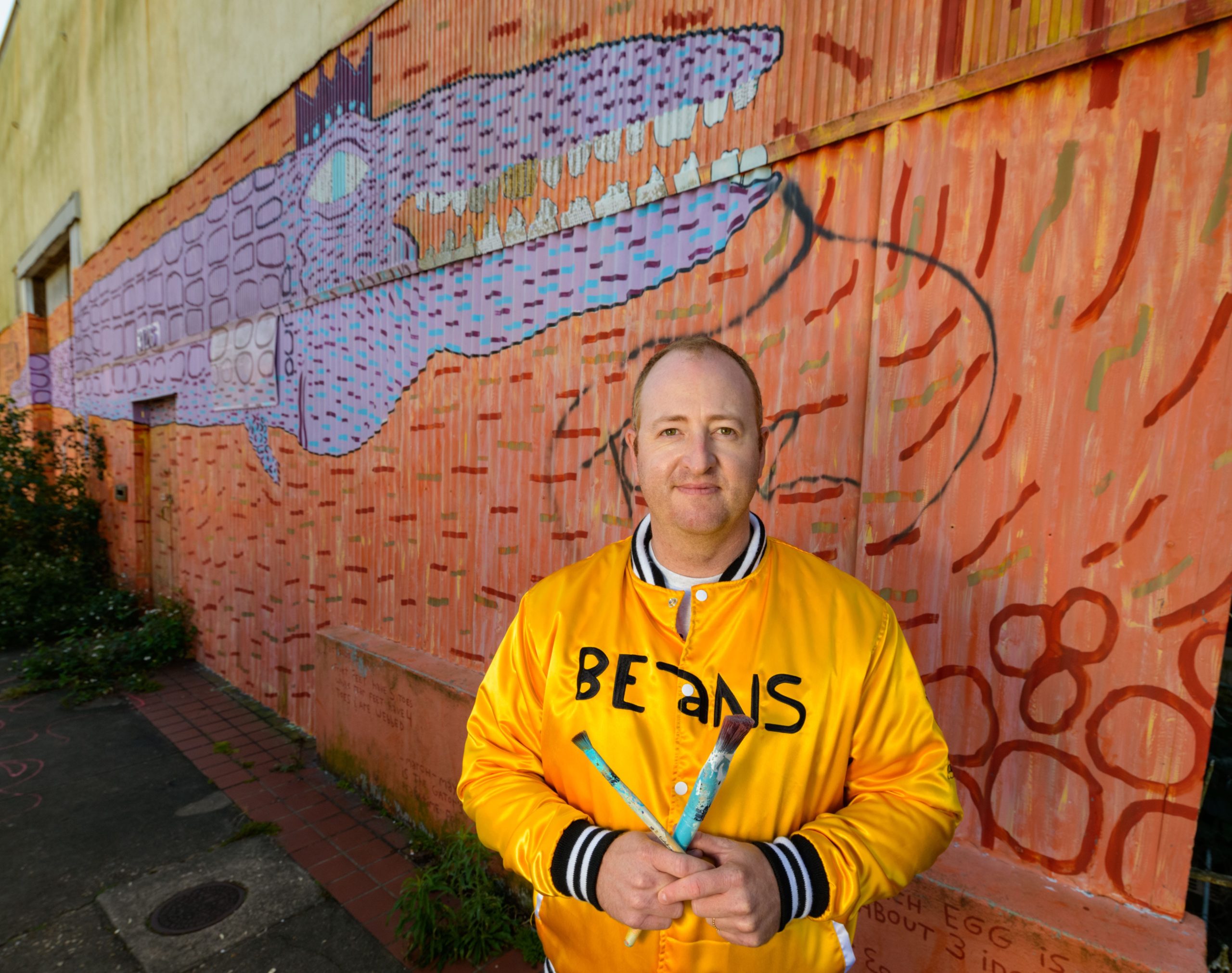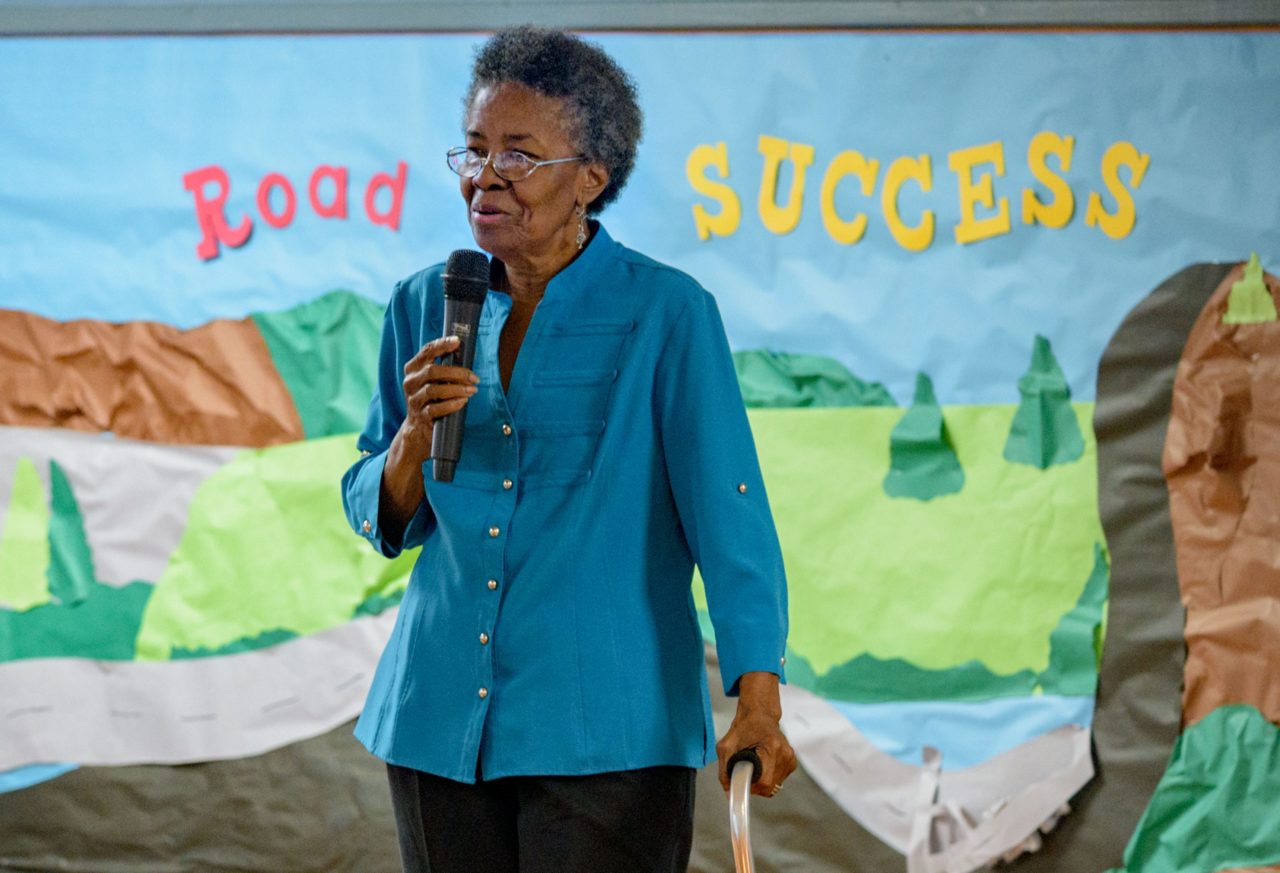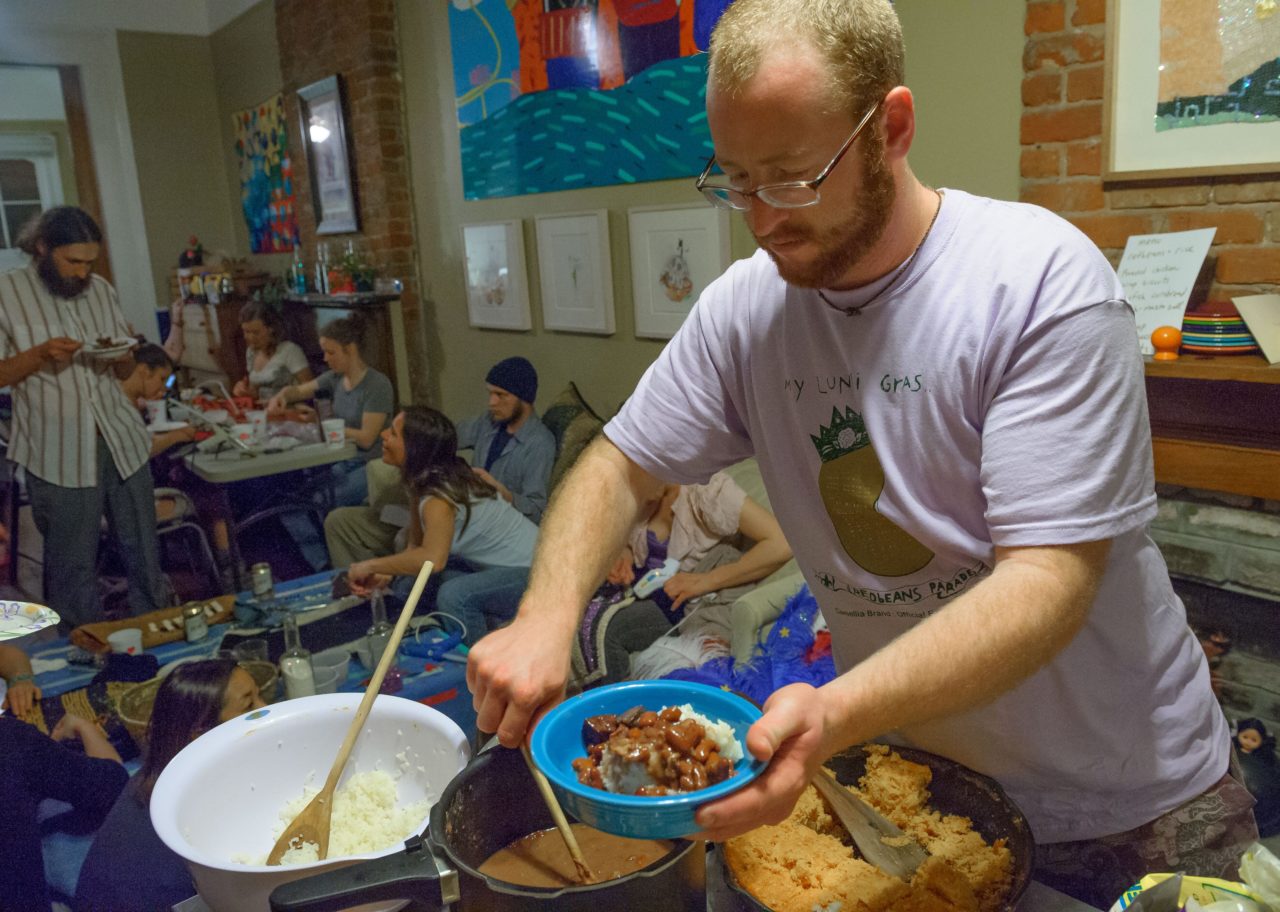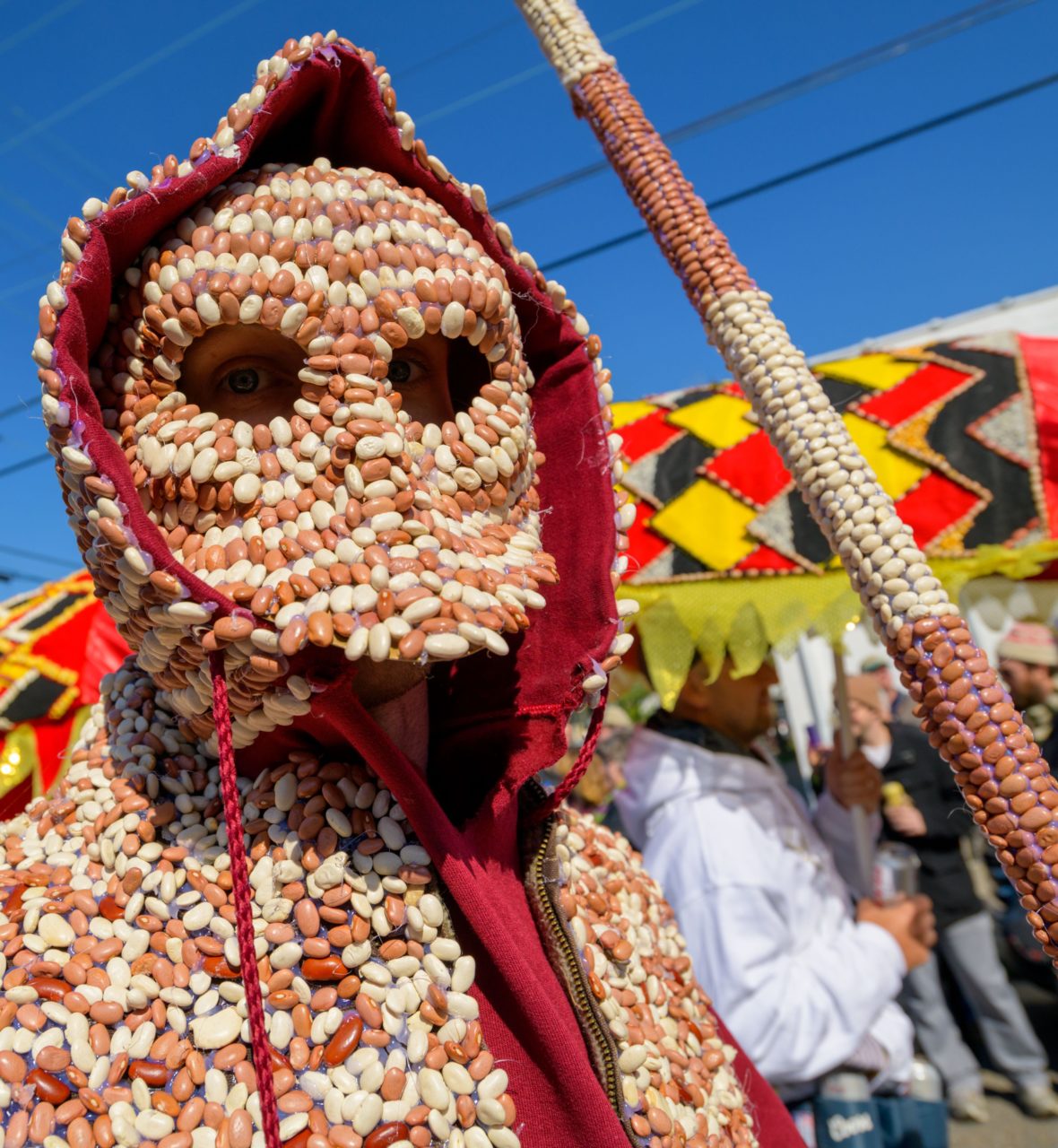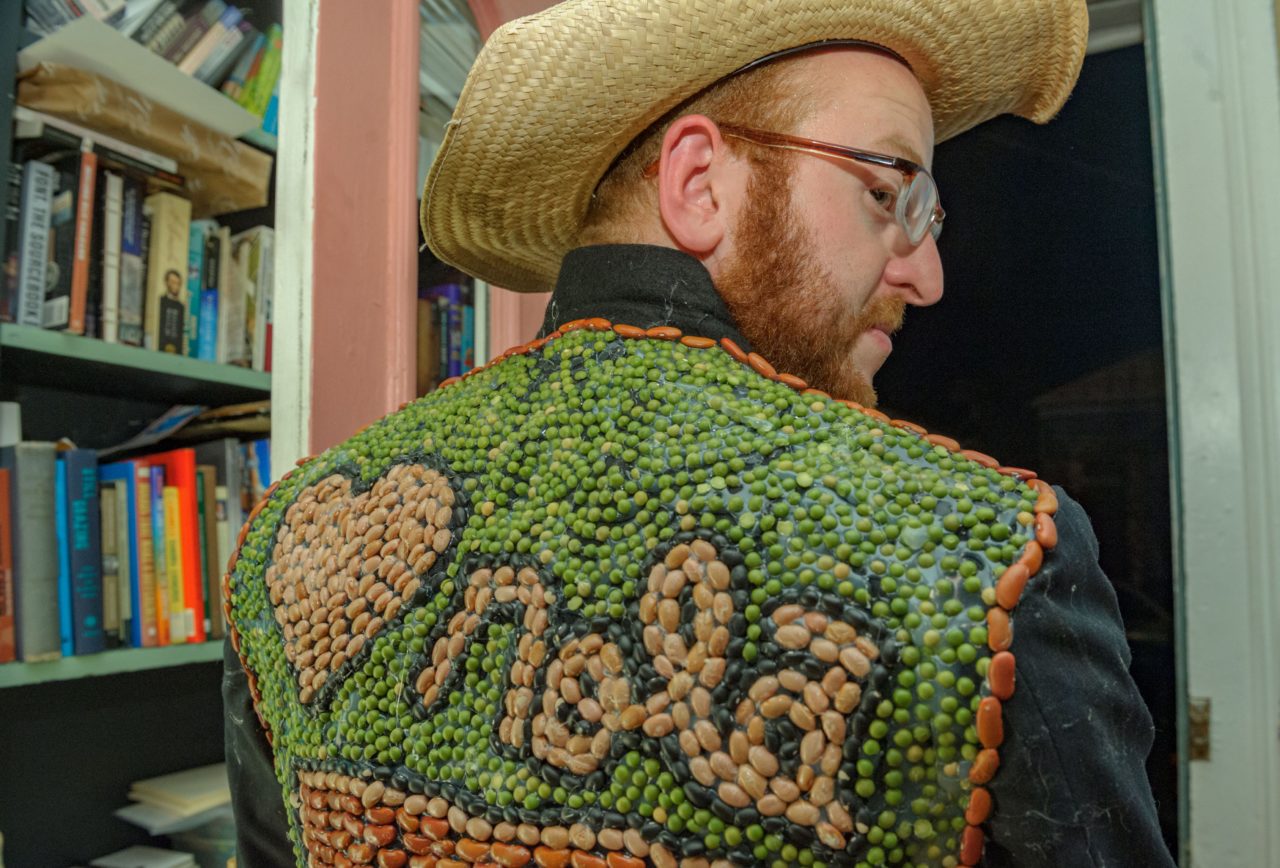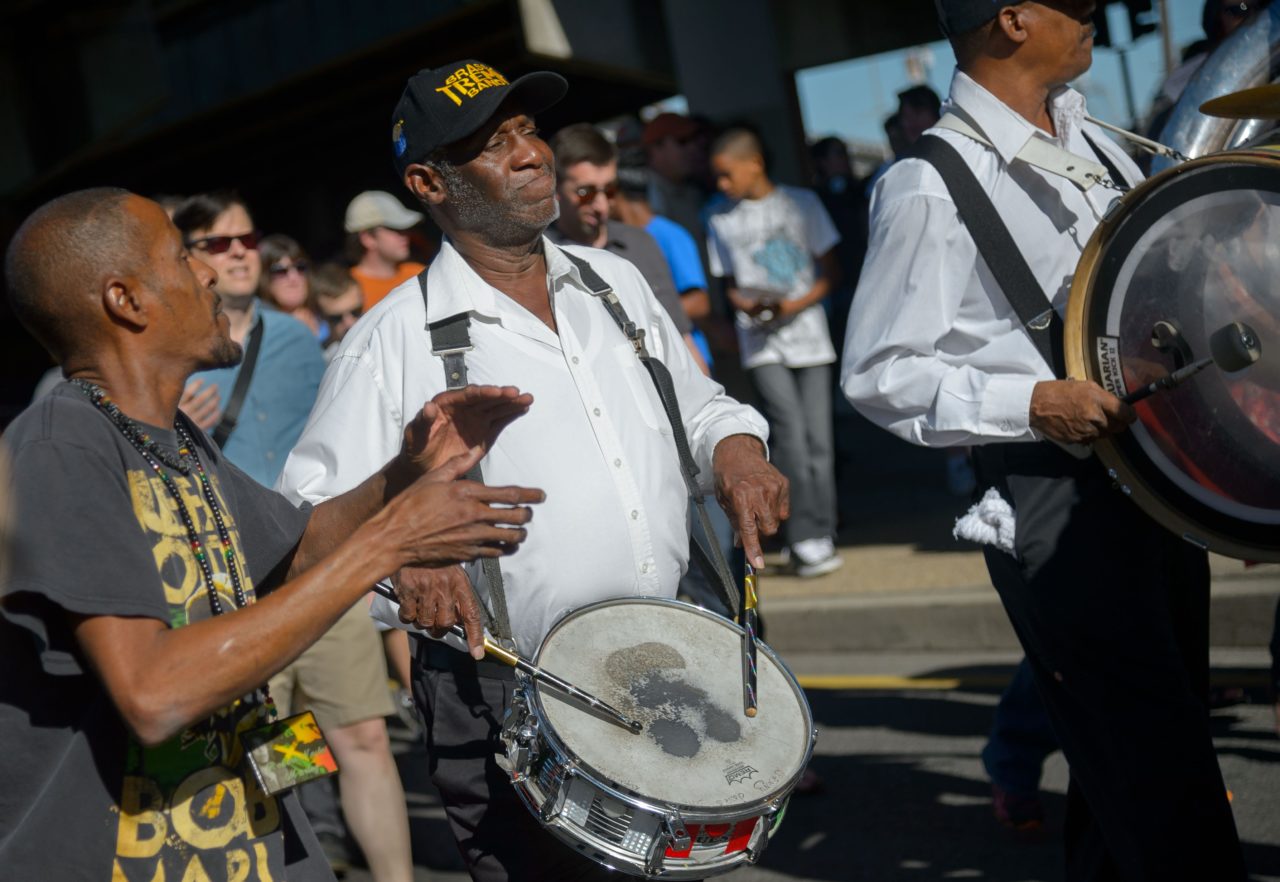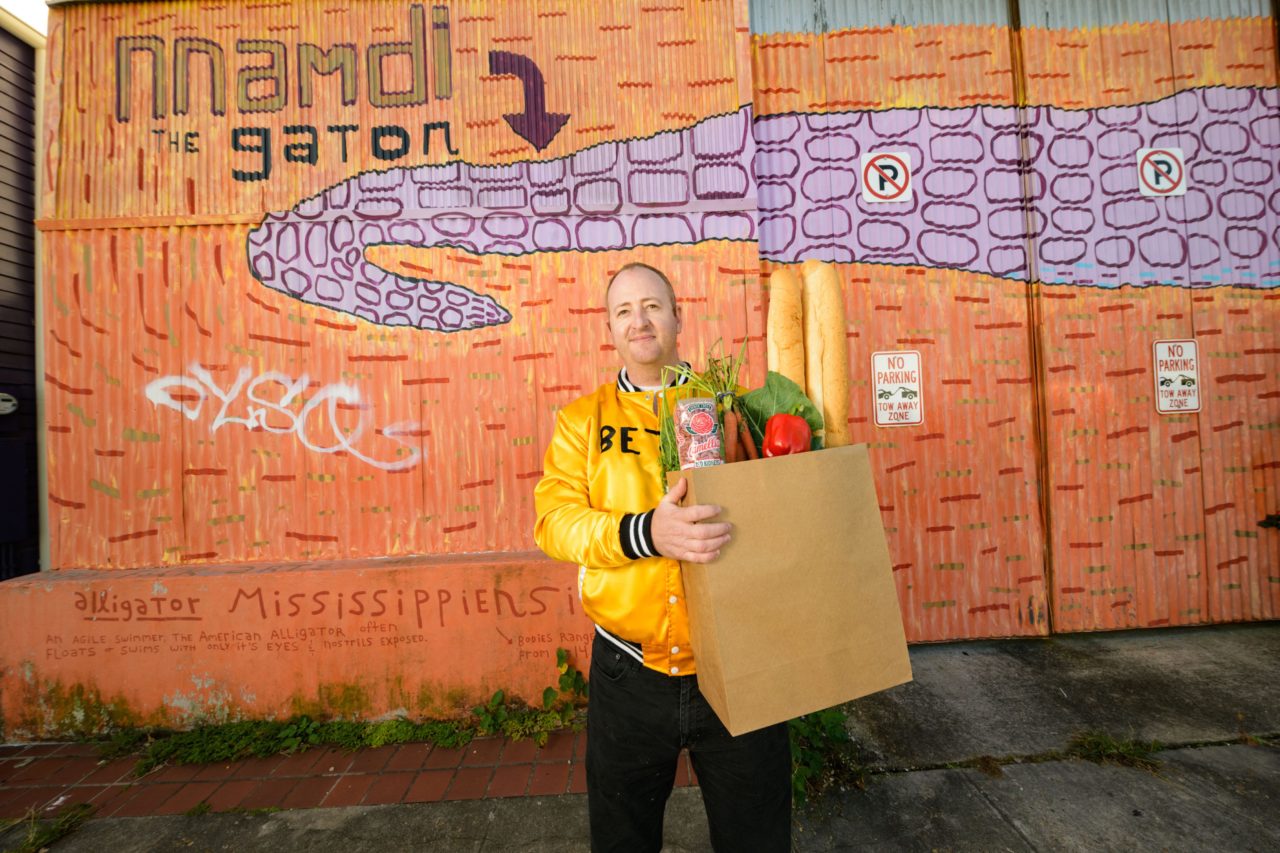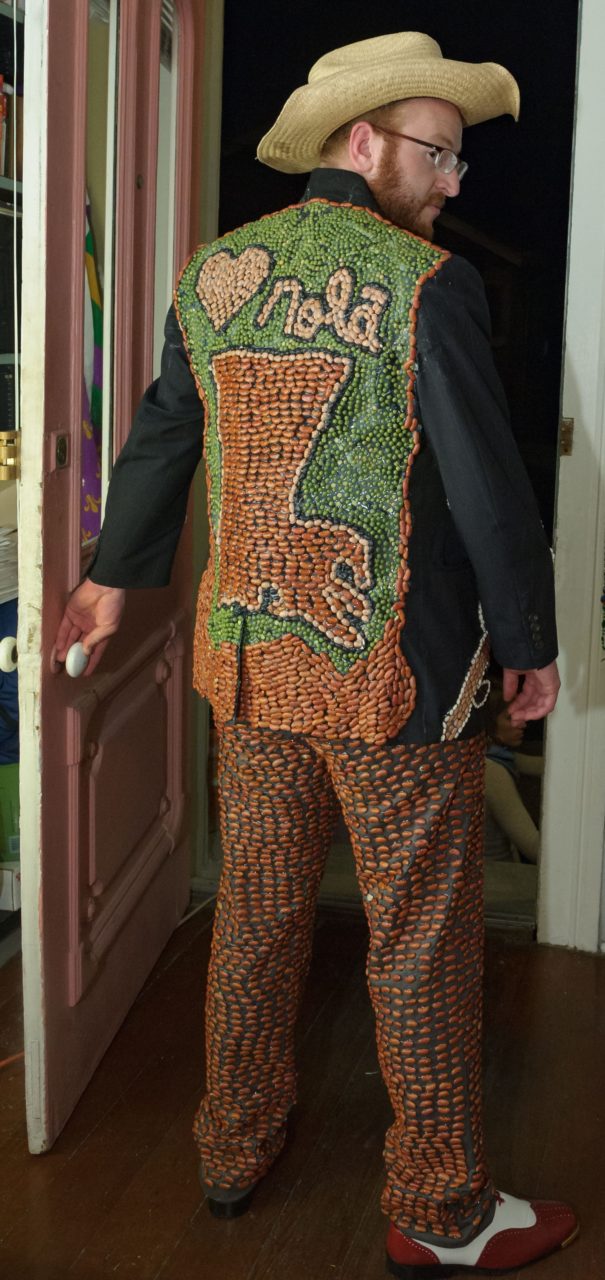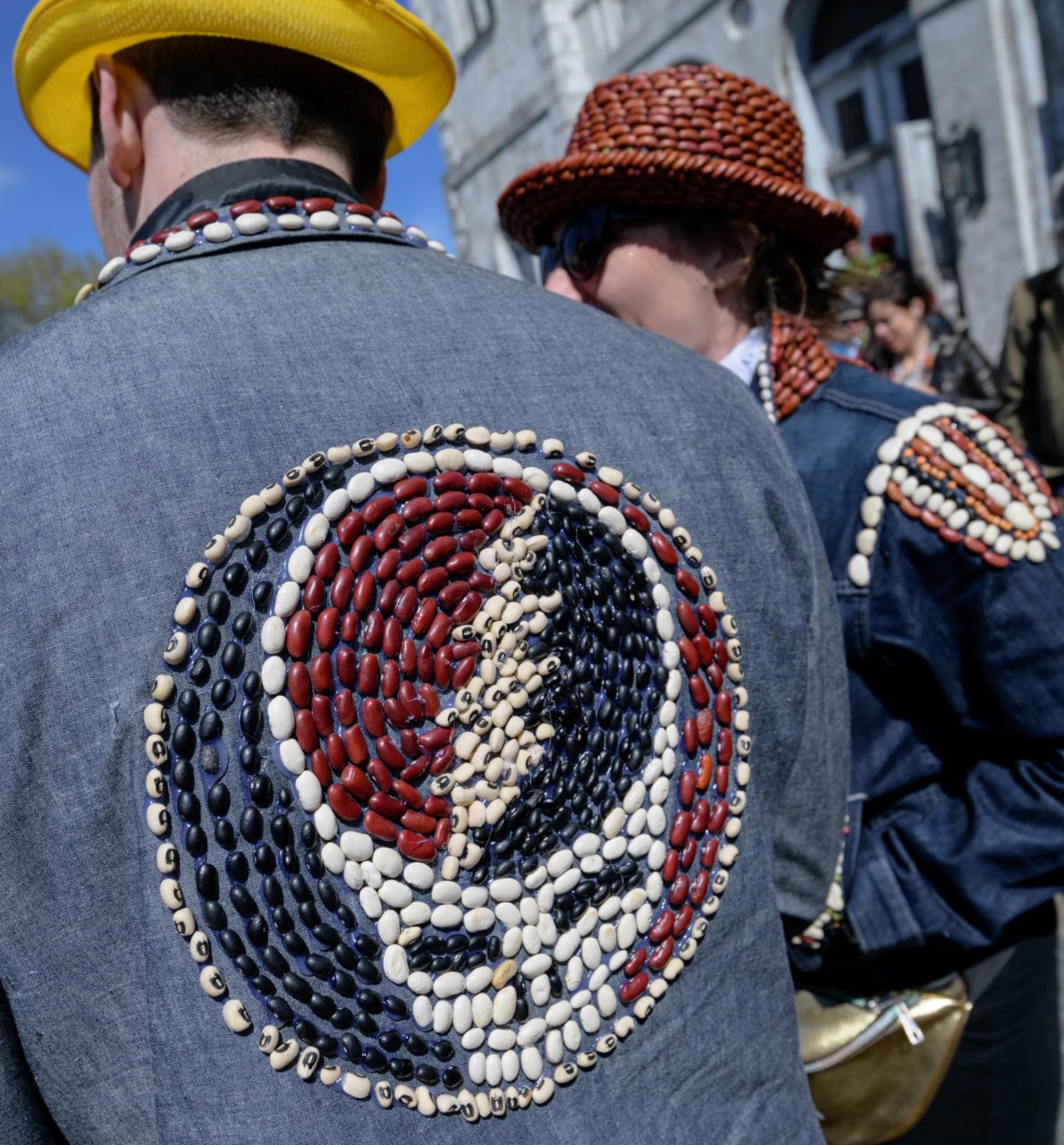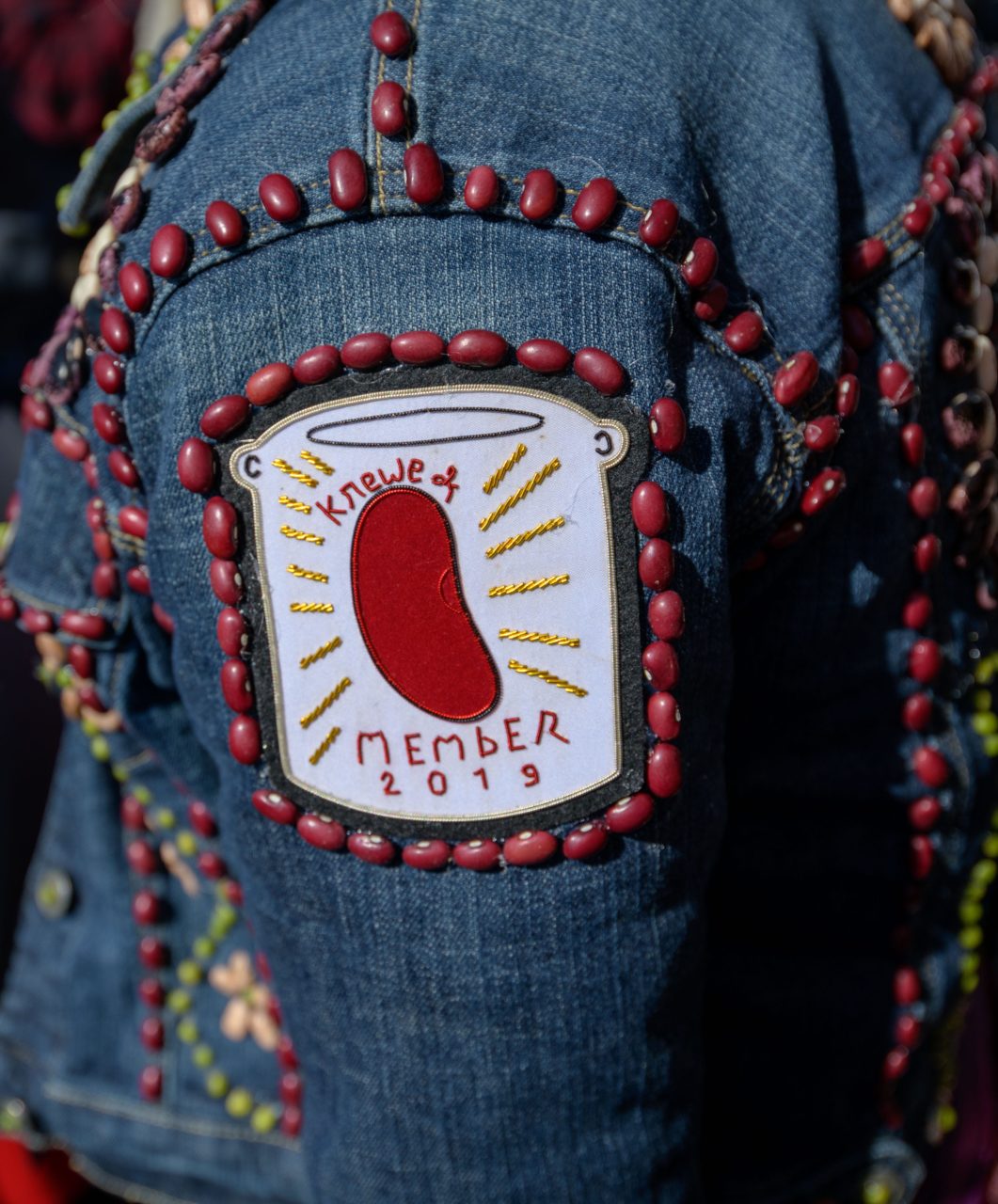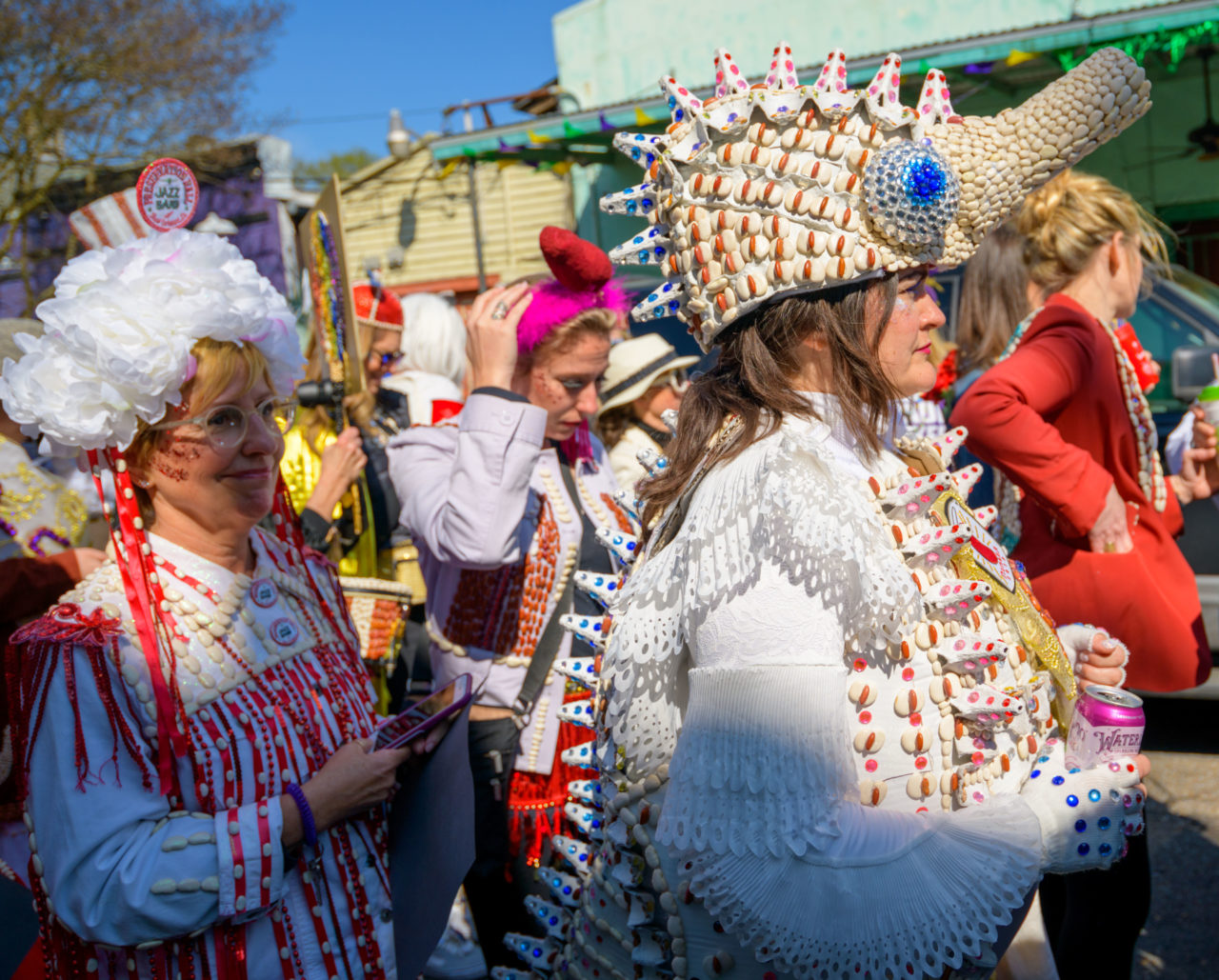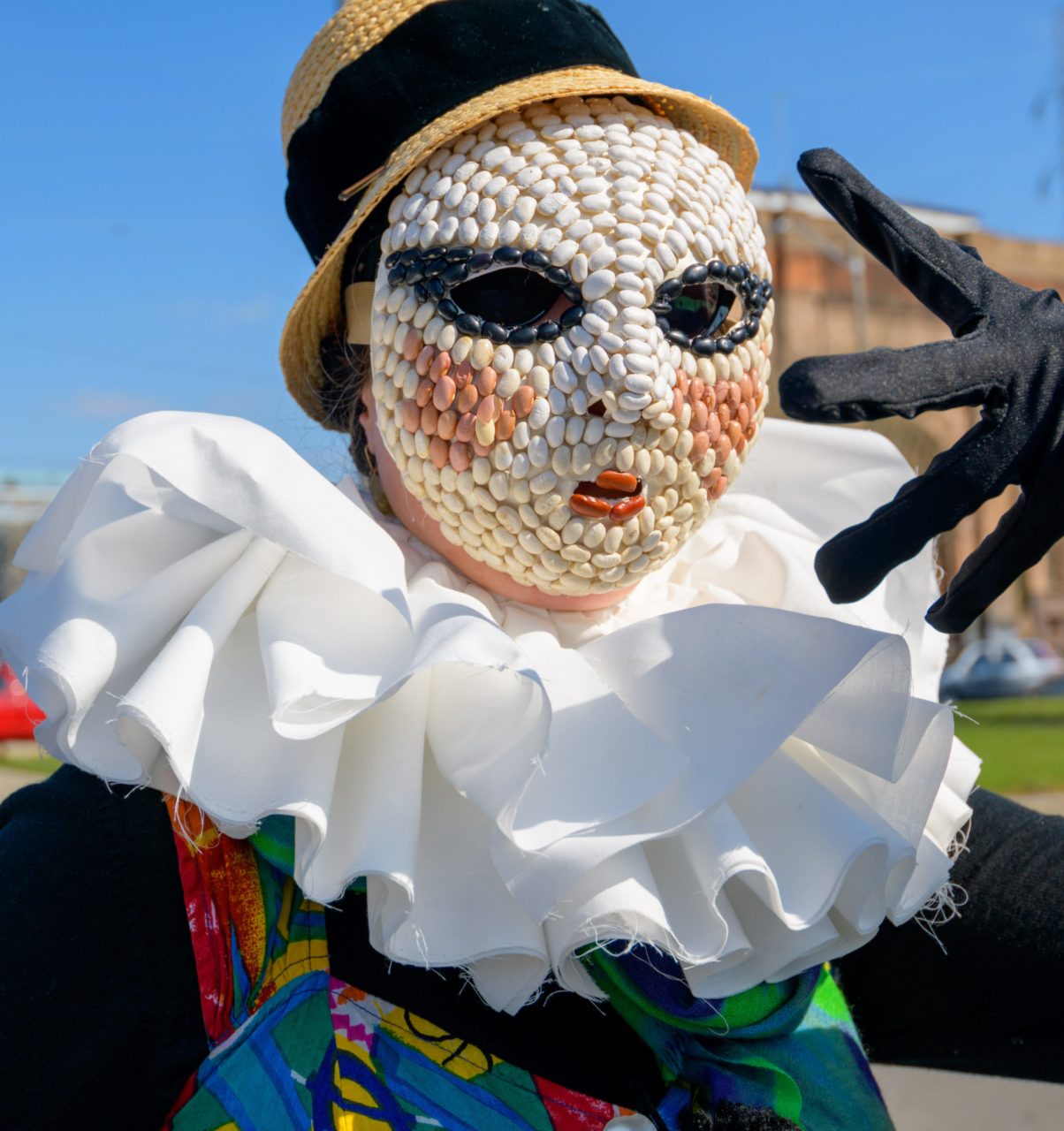Walking around the Bywater neighborhood in 2016, Krewe of Red Beans founder Devin De Wulf noticed a large graffitied building that had seen better days. Talking to the owner, he learned it was an old movie house. “If we do a mural, it’ll look nice and rectify the graffiti problem,” De Wulf said. The owner agreed and De Wulf saw the project not only as a chance to improve the vibe of the neighborhood but an opportunity to make art.
The swamps and different cultures of southeast Louisiana are big sources of inspiration for De Wulf’s art, so he decided to paint a giant gator for the mural. De Wulf is a self-taught folk artist, “My art is completely authentic to me — it’s how it comes out naturally.”
De Wulf didn’t train to become an artist, instead, he studied history and trained to become an eighth grade history teacher in New Orleans public schools. “Teaching is an incredibly rewarding profession,” he said. De Wulf loves the complexity and messiness of history and enjoyed leading young people into an examination of history’s different perspectives and watching his students become critical thinkers.
De Wulf taught for 10 years, and estimates he taught thousands of students.
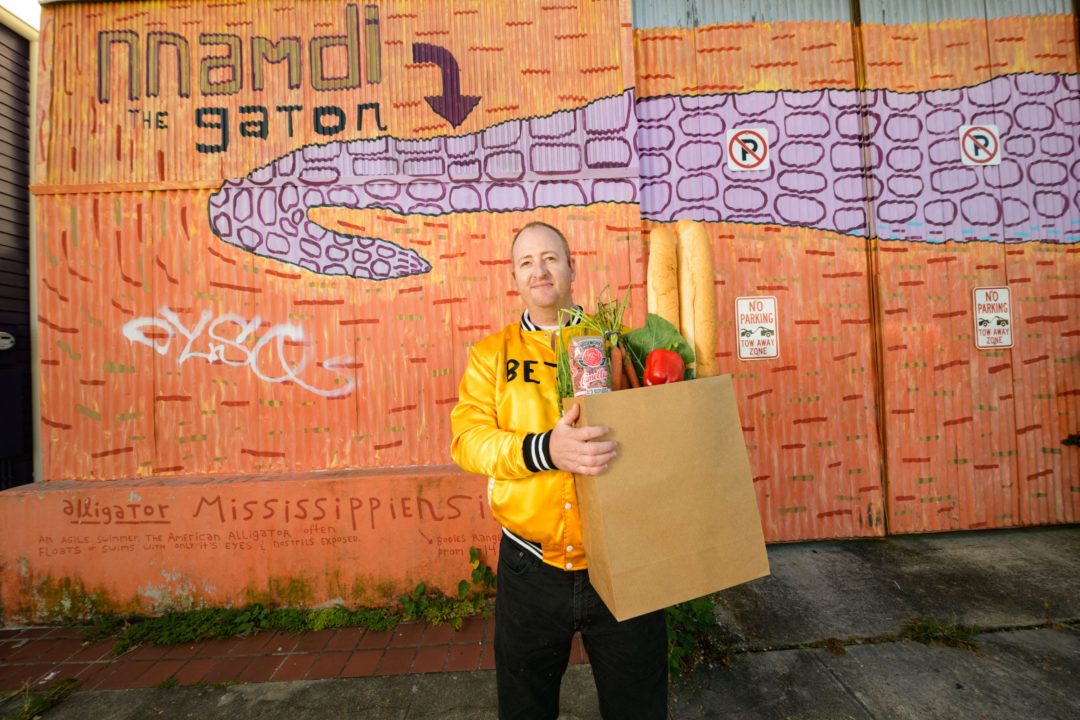
Remembering Nnamdi
Always the educator, he added interesting factoids to the mural like that alligators have five toes on their front feet while only having four on the back feet. As he continued to work on the mural, news broke about one of his former students.
On May 22, 2016, the bullet-riddled body of 20-year-old Nnamdi Louis was found in an abandoned grassy lot in New Orleans East. New Orleans Police have not identified or caught his killer.
De Wulf said of the eighth-grader he knew many years before, “Nnamdi was a super smart kid who had a mischievous sense of humor. He had a really big smile and was super charming, somebody that left an impression on you.” De Wulf felt Louis would grow up to do great things and that made his death extra shocking and tragic. “I think our city loses a lot of talent to violence,” he said. “I don’t know what path his life led after ninth grade, but I remembered him fondly.”
As he painted the mural De Wulf worked through his feelings of loss and named the mural “Nnamdi the Gator.” He recalled, “You become close when you’re working with students. And then they go on with their lives. That’s just the cycle of life.”
The Nnamdi mural was his first big mural in the neighborhood and De Wulf learned that painting in public often includes a lot of social interaction such as talking to neighbors and curious passers-by. He has since completed two more. “It’s kind of fun to slowly add more vibrancy to the neighborhood. To create art and have it in public is really rewarding.
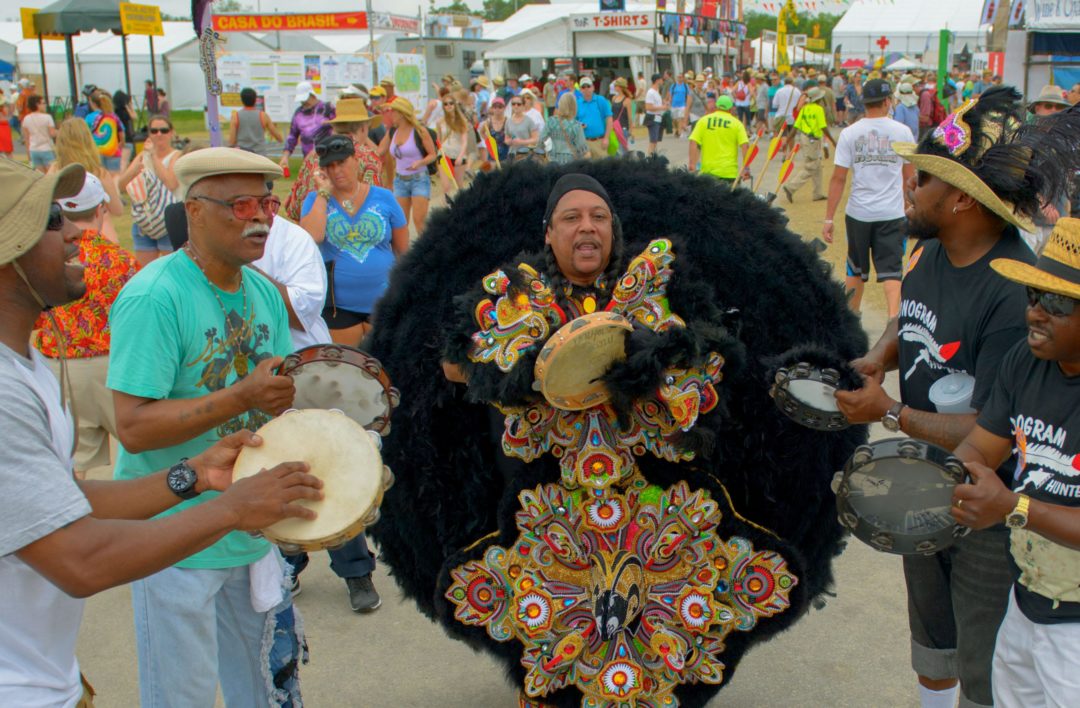
Defining Culture
Growing up in Charleston, South Carolina, Devin De Wulf had a different view of what culture meant. “I would say that when you live and grow up in another part of America, culture is something that you pay money to see.” De Wulf described buying tickets to attend art museums, or music shows and plays on stage. As he began to travel outside of Charleston, first as an exchange student to Brazil and later as a volunteer photographer in New Orleans after Katrina, his views on culture changed.
During one of his volunteer trips, he connected with the Mardi Gras Indian Council and photographed a Super Sunday. On a subsequent trip, he spent his first Mardi Gras with the Black Feather Mardi Gras Indians tribe led by Big Chief Lionel Delpit. De Wulf documented the final fittings and construction of the complex, elaborately-beaded, and feathered suits.
When the Black Masking Indians suited up, De Wulf noticed a transformation. “When they are masked up, they become a personification of the suit.” An empowered feeling comes over the Indians, as their feathers bounce to the beats of drums and tambourines, and as they sing and call out to other members of their tribe. The impressive spectacle of sound, color and movement touched De Wulf in a profound way. He said that witnessing the transformation is the most special thing that you can see or experience. He explained that in contrast to the culture he paid to see in South Carolina, “Here [in New Orleans], I feel like culture is created by the people for themselves and that’s amazing.”
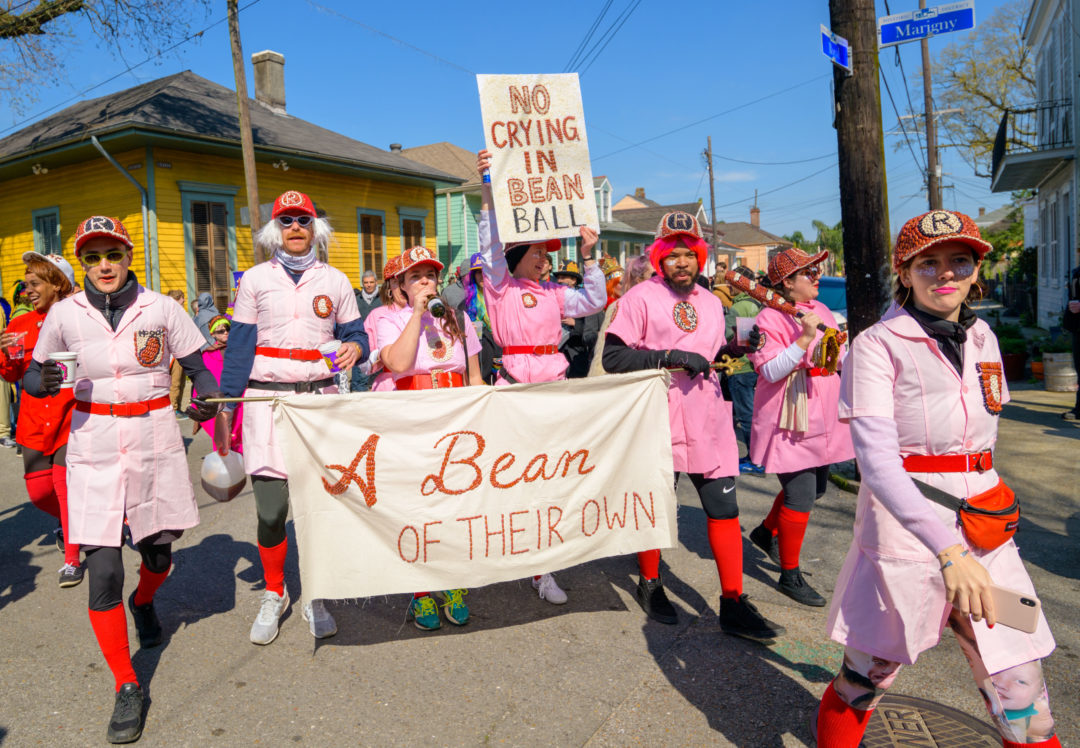
A New Tradition
When De Wulf made his first red bean suit in 2007, he decided to channel his personality into the suit as a work of folk art. “I wore it out on Frenchmen Street and walked around on Halloween and people freaked out, people really responded to it.”
Before living as an exchange student in Brazil, he never really ate beans or feijão. “Brazilians eat beans twice a day every day. It’s a huge part of their diet.” After six months of eating them in Brazil he was hooked. “Like, I sincerely love beans. They’re my favorite food. And then when I came to New Orleans, I did not know that they had the tradition of red beans and rice until my first Monday here.” After learning more about the cultures in New Orleans, De Wulf noticed that there wasn’t much happening during the daylight hours on Lundi Gras, the day before Mardi Gras. “So, I just decided, next year I’m going to start a parade, and that’s what I did.”
In 2012, then Devin Meyers met Annelies De Wulf when she joined a Red Beans parade. Originally from Northern Virginia, Dr. De Wulf came to do a residency at University Medical Center and decided to stick around. When they married, Meyers realized his wife’s family name would traditionally die out if she took his name because she only had sisters. Instead, Devin Meyers became Devin De Wulf “I think I upgraded my last name, it sounds pretty cool.” The couple now have two children born in New Orleans, a 5-year-old daughter, Anneka, and 3-year-old son, Markus. De Wulf is now retired from teaching to be a full-time stay-at-home father.
De Wulf has some advice for people who, for one reason or another, end up in New Orleans. Over the past thirteen years, he has approached his neighbors and culture-bearers as an interested and respectful visitor. He says that over time people will recognize the respect and eventually say “you’re welcome here.” De Wulf believes it is important for people to expose themselves to new experiences in the many wonderful and different neighborhoods of the Crescent City. De Wulf admits it has been awkward at times being an outsider “but, going to a second line is awesome, or going to see a Mardi Gras Indian practice is a special thing. And that is when you can start to learn, truly learn about the city where we live.”
During a Krewe of Red Beans parade, De Wulf had his own feeling of transformation, “when I put on my bean suit on Lundi Gras, I feel wonderful. And that’s the magic of the parade.” When he makes a new suit of red beans with hot glue, he finds the experience meditative and it gives him a greater appreciation of the time and energy the Carnival Indians spend beading and sewing over the course of months.
De Wulf has been fortunate to have other culture-bearers in New Orleans join his parade like Mr. Benny Jones, leader of the Treme Brass Band. Jones beats his drum with the band for the Krewe of Red Beans parade on Lundi Gras. “Mr. Benny is a super nice guy, like one of the nicest people, I think, in the world.” Jones introduced De Wulf to Sylvester Francis of the Backstreet Cultural Museum that celebrates Mardi Gras Indians and second line culture. Jones suggested ending the parade there with a block party in the Treme neighborhood and the fete has since become a yearly tradition.
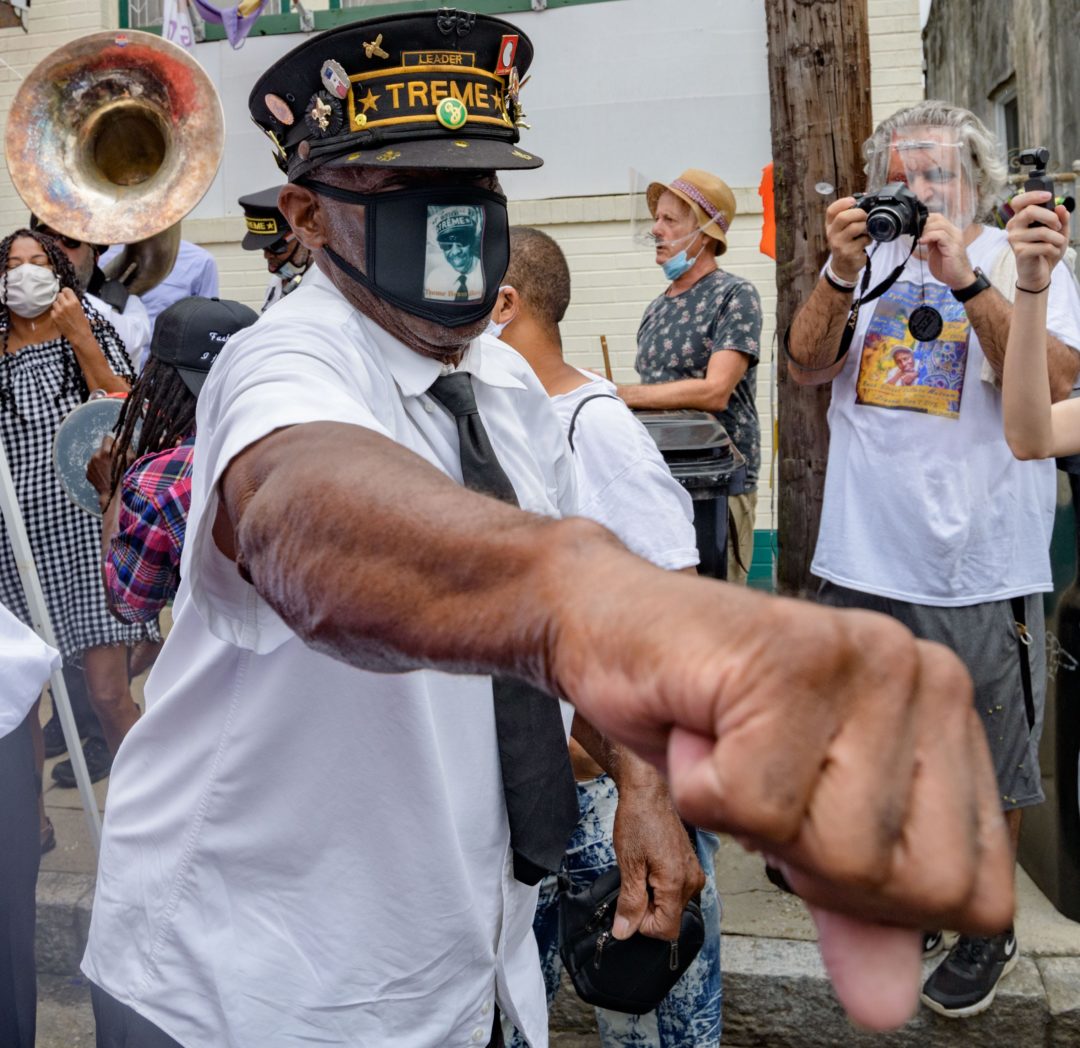
COVID-19 Crossroads
Many Carnival traditions are now on hiatus because of the COVID-19 pandemic, and De Wulf made the difficult decision to cancel the Red Beans Parade for Mardi Gras 2021. The City of New Orleans has since come to the same decision and has canceled all parades for the 2021 Carnival season.
In hindsight, Mardi Gras 2020 drastically increased the number of positive cases. Dr. Annelies De Wulf is an ER doctor at University Medical Center and has been on the front line of the pandemic response including helping treat some of the first cases of coronavirus in the state that started to pop up after Mardi Gras. Devin De Wulf recalled, “the start of COVID was incredibly stressful for all the doctors. There was so much uncertainty. They knew that they were risking their lives by going to work every day.” In the early days of the pandemic, hospital workers and EMTs didn’t have a steady supply of personal protective equipment (PPE). As New Orleans became a pandemic hot spot, many personnel were exposed. A shortage of manpower meant that they continued to work, and only quarantined when they tested positive.
Annelies and Devin De Wulf both ended up getting COVID. “Luckily it wasn’t as bad for us, but it was definitely a very real fear of what would happen next.” De Wulf said it was a big moment for front-line workers “to step up and save all of us. It was a remarkable time for them.”
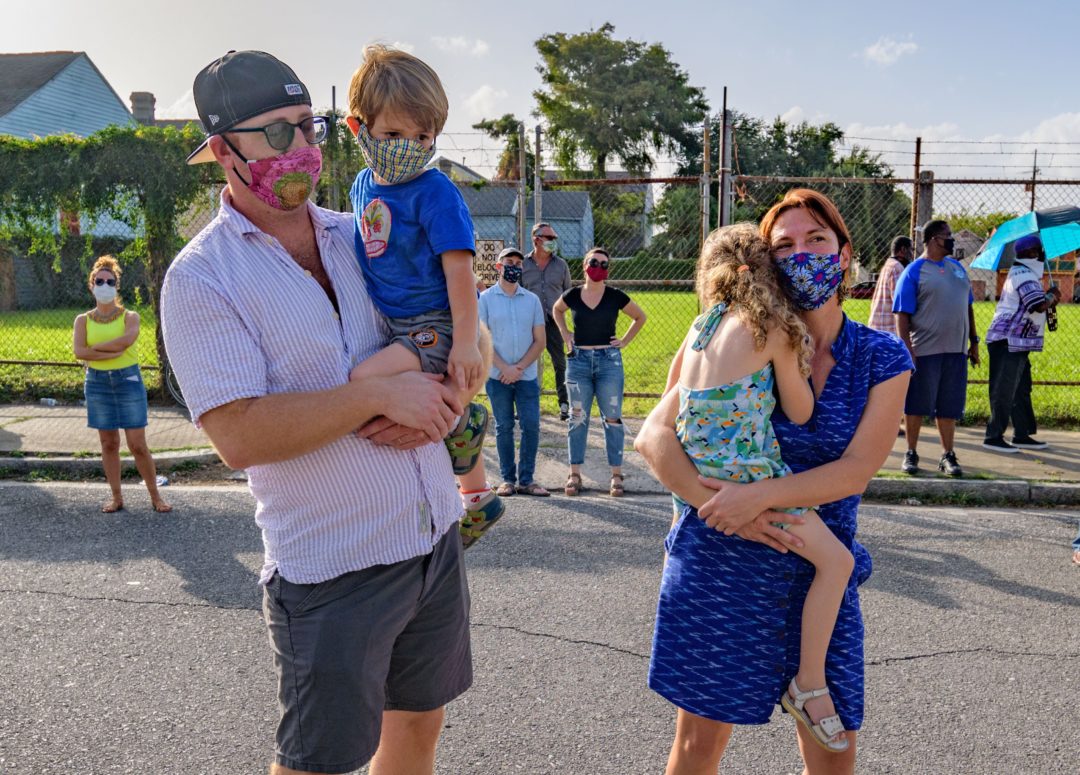
On one particularly stressful day in March, Dr. De Wulf related to Devin that a nurse had brought cookies to the ER to share. “That was kind of the aha! moment,” he said. He knew food-love brightens up everybody’s work environment, and also knew that restaurants would be hurting after the Louisiana governor ordered restaurants closed and limited to take out orders as the virus spread through the state. On March 16, De Wulf started out with a $60 order of food and delivered it to the hospital. He then put a plea on Instagram for donations and $1,100 was raised the first day.
That first small order transformed into feeding over 2,300 front-line workers a total of 100,979 meals and raising over one million dollars. Feed the Front Line NOLA also employed 25 out-of-work musicians to make food deliveries and employed 10 artists to help make marketing materials. De Wulf had found a win-win-win for the community by raising money for restaurants, boosting the morale of the hospital workers, and temporarily employing artists and musicians.
One of those musicians is a local Cajun drummer Paul Thibodeaux, who before the pandemic worked as a sideman drummer for different bands during live performances including Aurora Nealand and the Royal Roses, and Magnetic Gear, among others. “I’ve been a full-time musician my entire adult life thanks to the New Orleans gig economy, which is possible because of our tourism economy. Post-COVID there’s no tourism and the gigs dried up.” For Thibodeaux, the new delivery gig was a lifeline financially but also raised his spirits.
When making a delivery to the hospitals Thibodeaux could easily tell it was the highlight of their day. “They were over the moon,” he explained.
Thibodeaux said that occasionally in the middle of a delivery, they would be interrupted when a stretcher arrived with a new patient. “They had to go back into superhero mode and make sure the new incoming patient was okay. And then they snap back into the sweetest, most grateful people. It really… like, warmed my heart to be a part of that program.”
Forty-nine restaurants, including Tropicalia Kitchen, Heard Dat Kitchen, Queen Trini Lisa Island Soul Food, Joey K’s, Coast Roast, Pizza Delicious, and Backatown, gave hospital workers a sampling of New Orleans cuisine that they were missing and introduced them to new dishes. Heard Dat sent a crawfish etouffee that Dr. De Wulf said was very yummy but she was also surprised by a beef stew over risotto from Justine’s that she raved about for weeks afterward. When picking up an order of Cuban sandwiches with rice and plantains from Que Rico! Cuban Café, Thibodeaux said, “You could just tell that food was made with love. They were just thrilled to have the big catering-sized order and very thankful and they wanted to take pictures with me.”
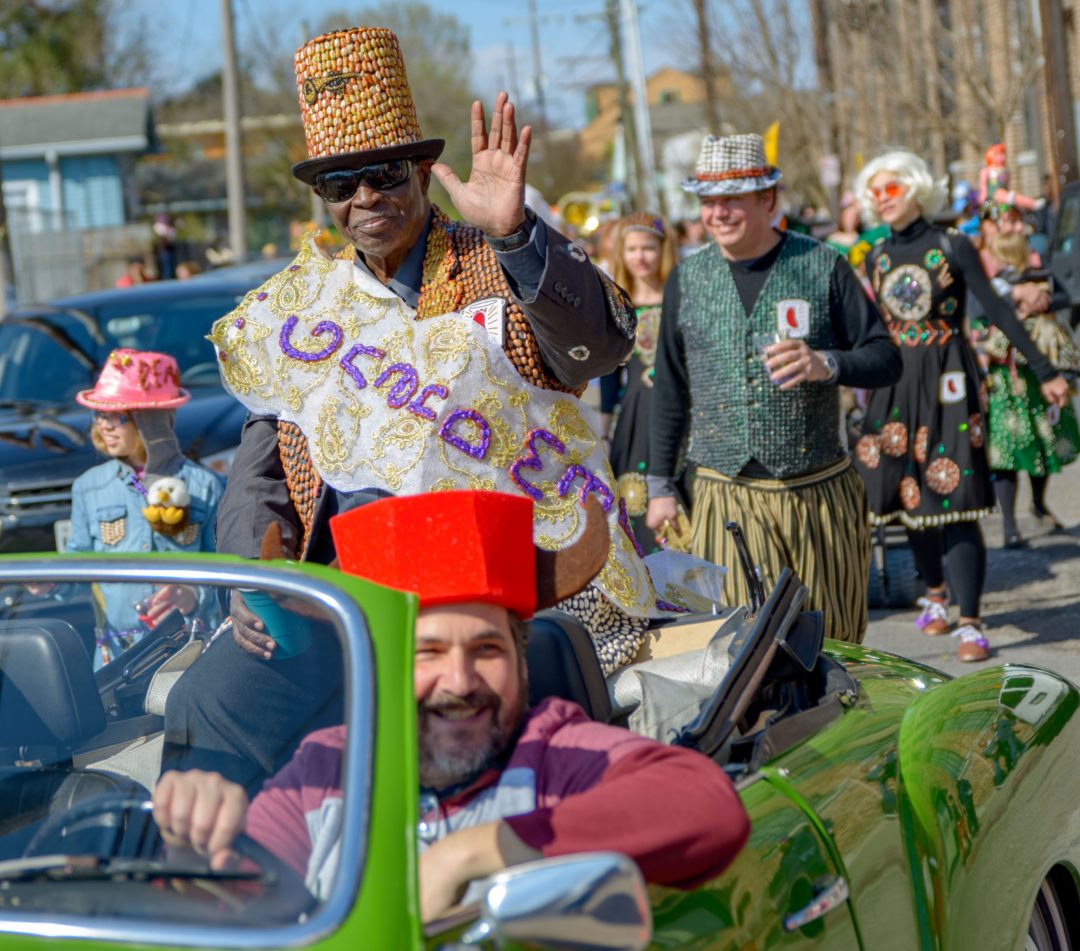
Feed The Second Line
Feed the Front Line was always meant to be temporary and served its last meal on May 3rd. But De Wulf and Thibodeaux have continued to serve the community with Feed the Second Line NOLA by the Krewe of Red Beans, https://www.feedthesecondline.org/, an organization that provides “food-love and employment to the culture-bearers of New Orleans.”
One such culture-bearer is the Krewe of Red Beans grand marshal, Al “Carnival Time” Johnson, singer of the Mardi Gras rhythm and blues standard “Carnival Time.” Johnson is 81 making him more susceptible to serious complications from the virus, but he still needs groceries. That’s where Feed the Second Line steps in to deliver food and supplies with minimal contact. Younger culture-creators make the deliveries including members of the Wild Tchoupitoulas Indians, the Panorama Jazz band, and Baby Dolls, among others.
But for Thibodeaux it’s more than just deliveries, he has gotten to hear stories from culture-bearers like Ashton Ramsey. Ramsey showed off his toys including miniature, buzzing instruments that he played with Uncle Lionel Batiste in the Dirty Dozen Kazoo Band, which later morphed into the more serious Dirty Dozen Brass Band. Ramsey is in his eighties and is known for his wild costumes of wearable folk art, which are collages of headlines, lotto tickets, or patches that tell a story. His work has been exhibited at Jazz Fest and the Ogden Museum of Southern Art during Prospect. 2.
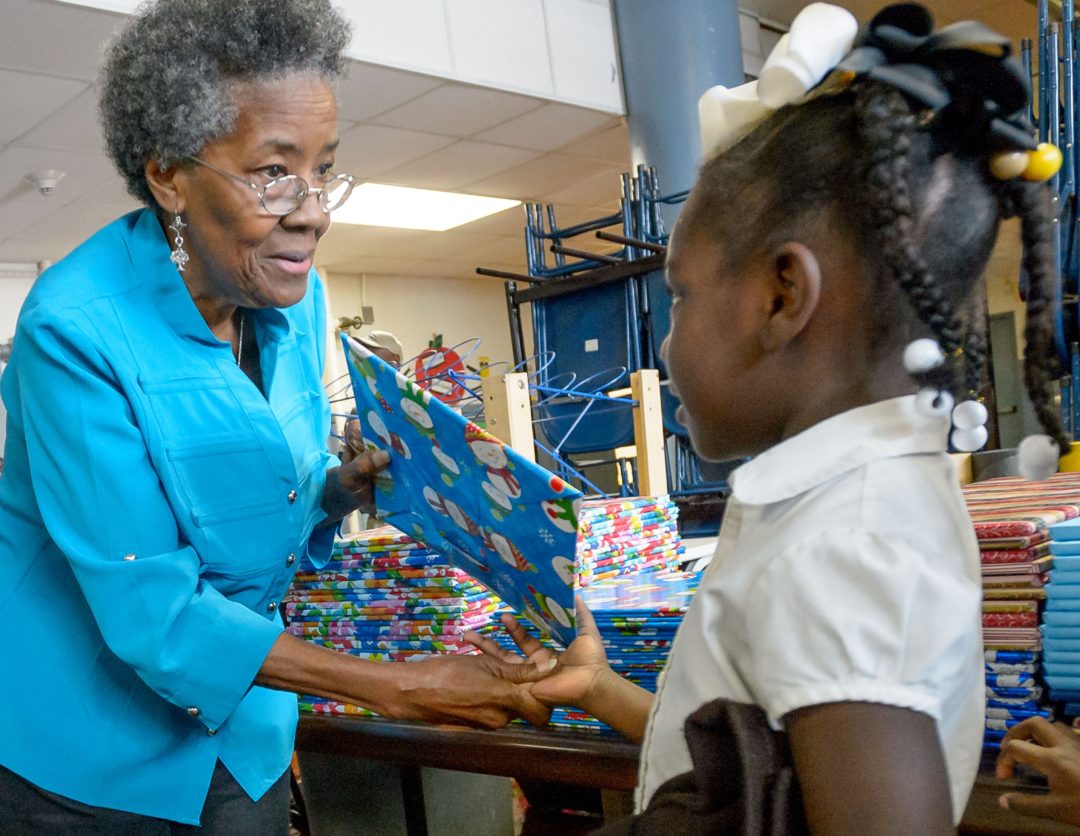
Photo by Matthew Hinton
After stopping to make delivery to Herreast Harrison, she gave him books to read to his two young children. Harrison is the founder, program director, New Orleans living legend and matriarch of the Donald Harrison, Sr. Museum, named after her husband, who was the Big Chief of the Guardians of the Flame Mardi Gras Indians and a prolific reader. To honor his memory, Harrison has organized book giveaways since 2006 of over 40,000 books to schoolchildren. “She has worked tirelessly for her community, for us to give her a gift and recognize her work means the world. For her, it has nothing to do with food or finances. It’s the fact that someone is looking out for her and saying, ‘Hey, if you need anything, stay in touch.’”
So far, $400,000 has been raised for feedthesecondline.org, which continues to operate during the pandemic. Thibodeaux believes the deliveries free the elderly culture-bearers up so they can keep working on their craft, like a Mardi Gras Indian sewing a suit. He said, “there is a living culture here in New Orleans and the culture lives within these people.”

